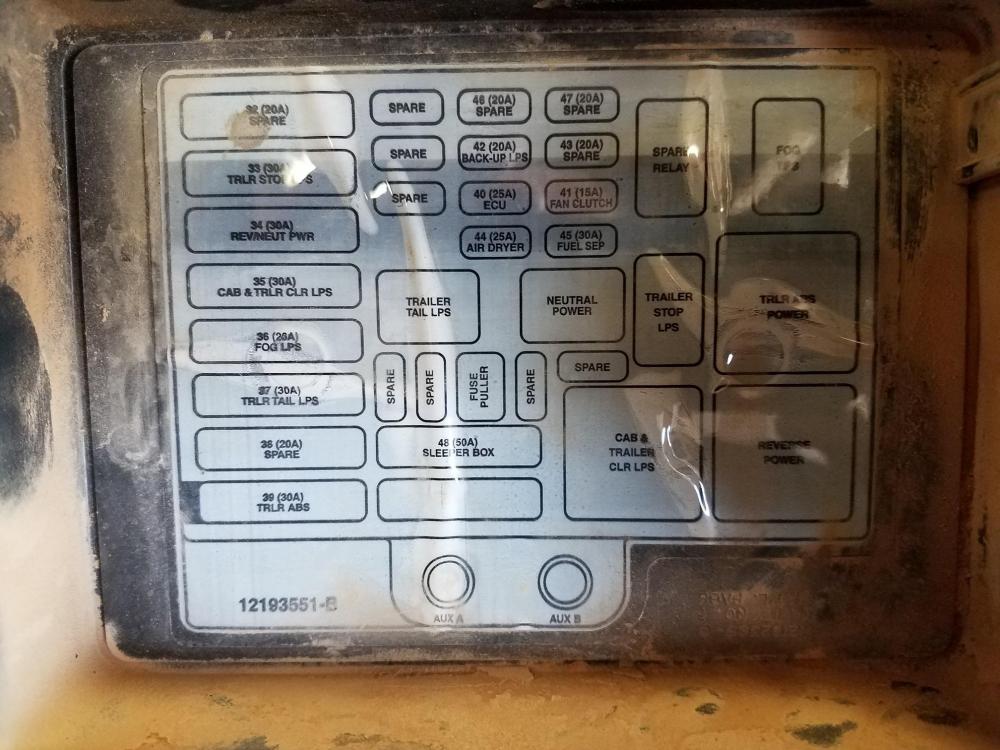-
Posts
402 -
Joined
-
Last visited
-
Days Won
1
Content Type
Profiles
Forums
Gallery
Events
Blogs
BMT Wiki
Collections
Store
Posts posted by turckster
-
-
The cruise and dash light circuits are not related. The cruise will stop working because of- bad /mis-adjusted clutch switch, service brake switch or that circuit activated, Fuse, short/open in circuit.
-
-
There are 2 types of electronic viscous fan clutches, the Borg-Warner and the Behr type fan clutch. The Borg-Warner is huge and probably what is on the engine. As stated above, unplugging the B/W fan clutch should engage it within 30 seconds according to service info (usually happens immediately). If the engine is equipped with the Borg-Warner fan clutch and it does not engage then it must be replaced and updated to the smaller Behr type fan clutch and kit. It also needs to have the EECU software updated.
-
6 hours ago, kscarbel2 said:
You must be the only person in America who feels as you do about Allison automatic transmissions. It's stellar reputation in America and around the world speaks for itself.
I never said it was a bad transmission, I just don't care for it and I don't think it would be a good trans choice for the OP"s question. BTW, I doubt I'm alone on how I feel about the Allison trans.
-
Personally, I would go for the Mdrive. The least expensive rout would be a manual trans but with it comes routine service(clutch adjustment). The Mdrive requires none of that but, as pointed out above, is expensive come clutch time. I'm not a fan of the allison trans. A few oil field companies tried to run some in their fleets locally and they were just a pure pain in the tush. Plus, any automatic trans robs horsepower.
-
The Ishift/Mdrive have a diaphragm clutch which is non adjustable. Volvo and Mack are pushing to have customers spec the AMT transmissions and I think they have been a pretty good trans. Most drivers that I talk to really like them.
-
The speedo sensor has an ohm value, the circuit does not have voltage other than what the sensor itself creates when the truck moves. Depending on type of sensor, the ohms should be approx 100-200 ohms, typically around 150-170 ohms measured either from the sensor itself or from the VECU.
-
 1
1
-
-
I'd check the bellhousing to make sure the mount flange still has some taper--hasn't been run loose. Also looks like it may need an input shaft by the looks of the throw-out bearing area. If the bellhousing is in bad shape then the only good thing its good for is parts.
-
Some coolant reservoirs have a burn hole in the pressure cap/overflow side that can cause coolant loss. Pushing coolant can also be caused from a bad air compressor head, leaking egr cooler, bad injector cup and cracked head.
-
After idling for about 5-10 min check in each fuel tank where the fuel returns inside the tank. If there is bubbles in one or both tanks then the cause is most likely injector cups. To make sure, check the small plastic cap at the fuel filter base (next to the primer pump) is not wet from fuel leaking around it. If so, the problem is the cap---leaking o-ring sucking air into system. You can get a replacement cap from Mack.
If ok make sure 7th injector air purge "t" check valve isn't leaking air back to fuel system. Remove the fuel line from the "t" fitting, turn key on and there should be no air coming out "t" fitting. Some '07 emission engines had the air purge line, some didn't .
If both above items look ok then most likely you have injector cup issues.
-
 1
1
-
-
Never seen that particular situation. Is 10% the highest duty cycle the 7th injector gets or does it get higher? Is aftertreatment fuel psi low across the board? I've had to replace the shut off valve because of low fuel psi.
-
I believe before you go to all the trouble to raise the engine high enough to remove the egr cooler that you can remove the egr valve without breaking bolts or stripping threads in the manifold. If that happens (which happens a lot)then you might as well remove the turbo and so forth.
-
11 hours ago, George h said:
I have a 2009 Mack with a mp-8 .
You turn on the key and crank the starter will engaged for about a second or less then it shuts off you can cycle the key and it will do it again it has a new wire harness new starter all the fuses and relays have been replaced the dealership is worked on this problem 4 different times and have not fixed it my question is it possible that the engine ecm is bad or the eecm I don't want to replace the wrong one
Sounds like the cam position and crank position sensor connectors are crossed. The ecu see's excessive speed and shuts off the starter.
-
Slowly and carefully run the knurling thread tool through the tip and use the threaded extractor to remove the tip.
-
 2
2
-
-
11 hours ago, dogg rescue said:
Is an e-6 thermostat the same as an e-7?
Should be, they all use the same tool to drive in the t-stat seal.
-
On 11/21/2018 at 7:47 AM, 305Mack said:
what is the FMI ? where is it located. Thanks for your help
FMI means Failure Mode Identifier, it tells you the actual failure be it short to ground, open circuit, erratic response and so forth. You have to use a diagnostic device(computer or Pro-Link) to see what the FMI is. For example, if the FMI is open circuit (FMI:5) then you know that somewhere in the circuit there is a damaged wire. You would look for obvious rub points or damaged areas in the wiring.
Take a good look at the sensor connector's terminals and make sure they making good contact and are not corroded. I've seen wires break inside the insulation at the connectors because of vibration so check for that as well.
-
7 hours ago, mp8_macky said:
considering the fact that i almost got bankrupt, i just have to share the following with you, it saved me.
no matter how much you invest in repairs - it won't run well.You get caught running what the link provides in an emissions state and bankruptcy issues are the least of your worries.
A quote from the bottom of the links page:
All product are intended for off-road use in competition only, and are not to be used on public roads or highways.
We don't take any responcibility where & how will You use the ECM, or will You or will You not remove the DPF/EGR/CGI from vechile. -
Check voltages and grounds at the eecu. On the left side of the radiator there is a cab to chassis harness connector. I have seen where the bolt connecting the two together have come loose or some pins having corrosion.
-
The adjustment for the clutch should be the same as a regular clutch cable type. 1/2" clearance between the clutch brake and throw out bearing. Adjust clutch brake and free travel should come out ok as long as everything is in good shape.
-
On a Mack when installing a reman engine and the original has a rear sump and the reman has front sump we just swap pans, oil pump pick-up and dipstick locations. I would imagine it would be the same for the Cat engine. New pan gasket, oil pump pick-up seals/gaskets.
-
From what I understood the reason for the torque turn method was because low torques can be had accurately, higher torques are inaccurate because of multiple turns or how someone pulls for the torque. If you set the initial torque low and a degree turn to achieve the final torque then each bolt torque will be more accurate and consistent. For example, E-7 and ETECH rod bolt torque had been 150 ft/lbs forever then all of the sudden it changed to something like 30 ft/lbs and 90 deg (or something like that-can''t remember exactly). Because most people were torquing rod bolts in chassis it could be a struggle to torque a bolt to 150 ft/lbs and many times it was inaccurate. But if you torqued it to 30 ft/lbs (easy peasy) then 90deg you would still get approx. 150 ft/lbs--just more accurate every time (when looking from an engineering point of view-- bolt clamp force and stretch).
The Snap-on electronic torque wrenches(3/8 and 1/2) are a life saver. The torque turns seem to be accurate. When the 3/4" first came out someone in our shop bought one--we were replacing many heads and doing inframe overhauls. Unfortunately it was inaccurate in both ft/lbs and torque turn. After some back and forth between us, Snap-on and the engineers who designed the torque wrench, they were finally able to work out the bugs.
-
 1
1
-
-
There is a fuel pump mounted behind the module, small little electric pump. When activated it boosts engine fuel psi to 90ish to help atomize fuel at the nozzel. 2007 emission non-catylized engines have the same pump but they are mounted inside the right frame rail mid-chassis.
-
If memory serves me correct, it's just a "t" fitting in both suction and return on the CH models. Could be wrong though. Won't be the first time. Or last.
-
Aftertreatment fuel psi should be what.... 90ish psi? What test is it that you can not perform that requires a special tool?






MP8 cups without injectors
in Engine and Transmission
Posted
If you have air bubbles in your return fuel you will have to determine where it is coming from. Most likely it is injector/cup issue. If there is no air in return fuel and is not hard to start then you have a problem elsewhere.
You can reuse injectors but it depends on the injector to cup wear pattern. On the conical tip of the injector if it has a uniform thin wear pattern around it and there are no signs of soot/carbon above it you can reuse that injector. If that wear pattern is thick and thin or there are signs of soot/carbon above it then it is not reusable. Any time an injector is removed the cup gets replace , can not be reused.